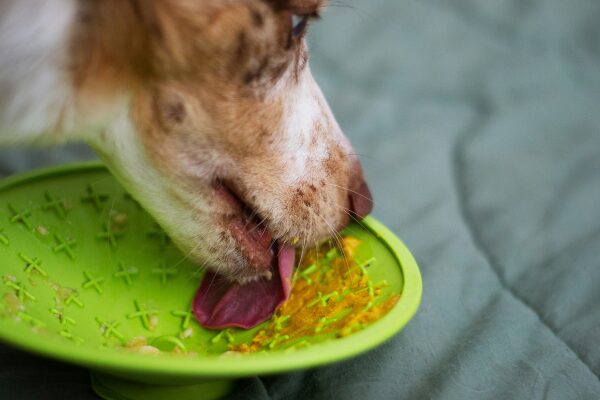How Food Can Help An Anxious Dog

DogFoodAdvisor is reader supported See how
Dog Food Advisor is 100% impartial and is never paid to promote any brand. But if you buy using links on this page, we may earn a referral fee.
If you’re the parent of an anxious dog, you may have tried all kinds of behavior therapy, training, or even used a pet psychologist to help your scared and confused pup. After all, we all want to help our dogs when they’re struggling with anxiety issues, just like we’d help our friends, family, and loved ones if they were suffering from mental health issues.
One thing you may not have considered, though, is how your dog’s diet affects their mood and behavior.
Your dog’s gray matter regulates their behavior — hormones and neurotransmitters affect their levels of aggression and stress, so the amount, and type, of nutrients your dog consumes at breakfast and dinner can have an effect on brain activity, resulting in changes in behavior 1.
As the saying goes, you are what you eat, so if your dog’s wolfing down low-quality food with the incorrect balance of protein, carbohydrates, nutrients, and vitamins, they may begin to display behavioral or anxiety issues. This could be due to the fact they’re lethargic and lacking energy, or they’re missing key nutrients for regular brain function.
Don’t panic, though: if your dog’s overcome with anxiety, a few simple dietary changes could have a big effect on their levels of calmness.
What are the signs of stress or anxiety in dogs?
As a diligent and caring dog parent, it’s highly likely you quickly recognize signs that your dog is stressed or anxious and take action to help them. But it’s not always obvious what the signs of anxiety are.
The main signs can include:
- Excessive yawning
- Excessive licking
- Ears flattened back
- Submissive posture
- Whimpering or whining
- Refusing to look at you
- Pacing back and forth
- Chewing items they shouldn’t be chewing (eg furniture or doors)
What causes stress in dogs?
The list of stress triggers in dogs is long and varied and can be highly specific to each individual, with some dogs, for example, being stressed by walking on smooth surfaces or traveling in a vehicle. These anxieties are often linked to a traumatic past experience, which they remember and link to an increase in fear and stress.
Two of the main stress contributors to dogs are:
Separation anxiety
Dogs with severe separation anxiety can cause damage to your house while you’re away, caused by anxiety at being left alone, or triggered by changes to routine including moving house or being re-homed.
Events or things that scare them
Loud noises often affect dogs due to their incredibly sensitive hearing, so dates like the Fourth of July can be a time of high stress, with all the extra noise and flashing lights that accompany the celebrations.
Some dogs also learn to know when you’re about to take them to visit the vet, so become anxious at the prospect. Other dogs don’t like going outside or having new people in the house.
How to help your dog
Once you’ve identified that your dog’s anxious or stressed, there are a number of ways you can help them.
If it’s a severe problem for your dog, you should contact your veterinary surgeon for an assessment, as they can recommend the right course of action and prescribe medication if they think it’s required. They might refer your dog to a behaviorist.
Exercise is one common way to help your dog release built-up stress or tension. Play with them outdoors or indoors — just like with humans, mental health can be improved through exercise, so keeping them active and engaged will benefit their anxiety levels.
Changing their diet can also help in ways you may not expect.
It can boost gut bacteria
Scientists are still investigating and discovering how the gut’s bacteria can affect general health, not just in humans but also in our canine companions.
There’s an increasing amount of evidence a dog’s gut biome can affect their stress levels. Studies have found a strong link between a healthy gut microbiome and the brain in humans and reveals the importance of a healthy microbiome for patients suffering from anxiety and depression 2.
Ways to boost your dog’s gut bacteria include giving them probiotics and prebiotics, or fermented foods such as unsweetened yogurt, kefir or sauerkraut as well as non-starchy, fibrous vegetables including broccoli, carrots, cauliflower, or leafy greens such as kale and spinach.
Ensure they’re getting the right amount of protein and carbohydrates
If your dog isn’t consuming a balanced diet with enough protein, their muscles may begin to break down in order to provide the blood with enough protein. This will result in a loss of strength and energy, and this lethargy in turn can lead to increased levels of anxiety due to a lack of movement and exercise.
Additionally, if your dog’s sugar levels spike too high, it can also induce feelings of stress and agitation. This can sometimes occur if they eat dry food that contains high levels of high-glycemic carbohydrates such as corn, white rice, or potatoes.
Getting the correct balance is tricky, but looking carefully at ingredient and nutrition information on food labels will help.
Provide a balanced diet with plenty of vitamins
Certain vitamins and minerals have been linked to aiding brain function, specifically in relation to stress. It’s been suggested vitamin B6, found in abundance in fresh food, is good for lowering stress as it converts tryptophan into serotonin, which has been found to help boost mood.
Omega-3 is also important for anxious dogs. Not only does it aid brain development, but low levels have also been linked to higher levels of aggression 3. So it’s important to ensure you provide your dog with a balanced diet packed with vitamins and Omega-3.
Use a lick mat
There are various rubber lick mats available that encourage you to spread your dog’s food or treats — such as peanut butter or yogurt — upon it like a big chewy, open-faced sandwich.
Acting as a distraction technique/therapeutic tool, it can help calm anxious dogs by encouraging the licking action as well as keeping their brain engaged while they attempt to lick off every last morsel of delicious food.
Final word
The Dog Food Advisor does not accept money, gifts, samples or other incentives in exchange for special consideration in preparing our reviews.
However, we do receive a referral fee from online retailers (like Chewy or Amazon) and from sellers of perishable pet food when readers click over to their websites from ours. This helps cover the cost of operation of our free blog. Thanks for your support.
For more information, please visit our Disclaimer and Disclosure page.



